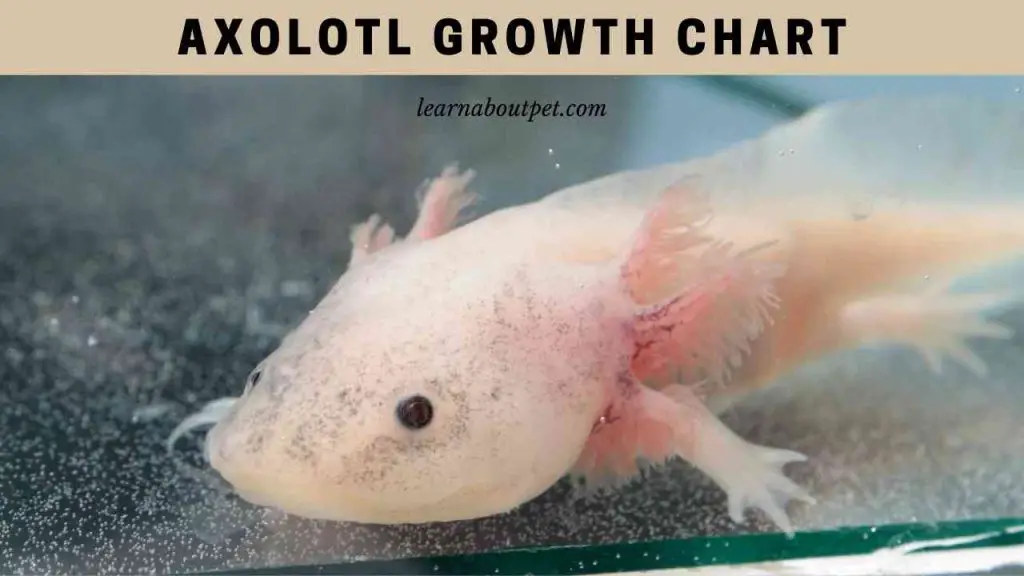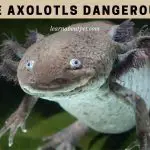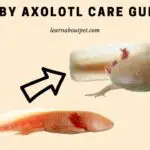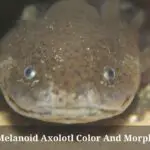Axolotls are considered exotic pets. These pets almost look like floating dragons, which is a major reason that makes them such attractive pets. One of the concerns, when petting an axolotl is that there is a lack of information on pet axolotl and many owners don’t know how will their axolotls grow and when will they reach maturity and peak of their life.
To understand the growth of Axolotl, it’s recommended to see the Axolotl growth chart, which carefully divides the major physical changes according to the age of axolotl. The life of an axolotl can be divided into 6 stages. From egg to the embryo, larvae stage 1, larvae stage 2, young adult, to finally adult axolotls.

How Long Does It Take Axolotls To Grow?
Axolotl rearing from Egg to Adult will be a really fast process. An owner can expect their pet to grow to complete maturity by the first six months of their birth. So this period of transition can be changed very consistently.
Furthermore, the owner should know that axolotls’ growth also depends on their environment. So, owners should make sure to be careful with the environment of the axolotl.
To answer the question: How long does it take axolotls to grow? It can take up to 9-24 months for an axolotl to grow fully.
How Can You Tell How Old An Axolotl Is?
How can you tell how old an axolotl is? An owner can tell the age of axolotls by their size however it may not be as accurate because, sometimes axolotls stay small due to health conditions, environment or nutritional deficiency.
The age of axolotls can be determined by dividing the phases of axolotl’s life which are mentioned in the axolotl growth chart.
What is the normal growth rate for axolotls? An average healthy axolotl would be as long as 4-5 inches long when they are 4-6 months old. When an axolotl isn’t taken care of properly, it may not grow more than 4-6 inches in a year. It highly depends on the care that the owner provides.
How Long Do Baby Axolotls Take To Grow?
How long does it take for a baby axolotl to grow? An axolotl doesn’t take a lot of time to grow. The owner of the baby axolotl would be able to see major changes in axolotl within the first month if the axolotl is kept in good condition.
An axolotl will be fully matured by six months from their birth and an axolotl will grow to full of their length by the time they turn one year old.
What are axolotl growth stages? According to the axolotl growth chart, their growth can be divided into 6 phases.
What Is Axolotl Growth Chart?
How long do baby axolotls take to grow? The axolotl size by age can be divided into 6 phases. Axolotl life cycle diagram is given below in the axolotl growth chart in detail
| Egg stage | This stage is also called the mating stage because many owners mate their axolotls. Owners most often breed their axolotls from December to July. Once mated successfully, the owner will see the mother axolotl with a swollen belly carrying eggs. This is the very first stage of the development of axolotl. A female axolotl will lay eggs after mating. A female can lay up to 1000 eggs at a time. Once the female has laid eggs, the axolotl will grow inside it to become an embryo. |
| Embryo Stage | What is the second stage of an axolotl? After getting released from the eggs, axolotls will go on to become small embryos. During this period an axolotl is as small as 2mm in diameter. They are generally surrounded by a jelly-like substance to protect the embryo. After some time, the embryo will grow more to get a more axolotl-like shape. It will start to form its shape. However, during this stage, the embryo won’t develop legs. Around the end of this stage, the axolotl would be grown up to 11mm. To answer: What is the second stage of an axolotl? It would be the embryo Stage. |
| Larvae stage 1 | During the first larvae stage, the larvae are dependent on their parents and require the support of their parents. During this stage, the owner may be able to see through the skin of larvae because larvae are developing and their skin is too thin to hide internal organs. During this phase, the larvae are very vulnerable and shouldn’t be touched. Furthermore, larvae stages are divided into two parts because during the first stage, larvae won’t have any legs but as the larvae stage 2 starts, it will start developing the legs. |
| Larvae stage 2 | During larvae stage 2, the legs will start to develop in larvae. During this stage, legs will develop before the rear ones. It can take weeks for larvae to develop to this stage. It is often noticed that during this stage the growth will slow down until the axolotl reaches the adult phase. During this phase, diet is very important, so owners should provide good and healthy food to their pets. |
| Young Adult | This is the phase when axolotl starts to become more independent and during this time, axolotl would get into a perfect shape and look like a baby axolotl. |
| Adult axolotl | This is the stage when axolotl matures. This is the time when it can breed. It is also called the last stage because there won’t be any major physical changes coming in the body of axolotl till the end of their end of life. |

Do Axolotls Grow To The Size Of Their Tank?
Yes, the axolotl growth rate depends on their tank because they are very sensitive to their environment. Even the food that an axolotl will eat will determine the axolotl length to age ratio. Some axolotls that don’t get enough nutrition or those who are kept in poor environments, would not grow and may even become stunted.
Why Isn’t My Axolotl Growing?
An axolotl grows fast. How long does it take for an axolotl to be fully grown? The owner can expect their pet to grow up to 8-10 inches by 12-18 months. Sometimes it can take up to 24 months but that is not common.
If the axolotl isn’t growing accordingly, it can be because of some of the factors that are mentioned below:-
Lack of Nutrient Intake
One of the most common causes of an axolotl not being able to grow to its full potential is due to the improper or poor quality food, it might be getting. Sometimes axolotls won’t eat the food that the owner provides, sometimes owners make the mistake of providing good food to the axolotls.
Axolotls need to have protein, minerals, calories, and vitamins for them to grow. Lack of people nutrients, they won’t grow and even get a disease or in some cases even die.
Ill axolotl
Sometimes, axolotls don’t grow because they have a disease or illness. There are many parasites, bacteria, viruses that can stagger the growth in axolotls. To prevent that from happening, the owner should keep an eye on axolotl and make sure that their pet is fit and healthy.
The owner should know that lack of appetite, lethargy, lack of movement are all signs of the unhealthy axolotl. If the owner thinks that their pet is sick, they should take them to the vet as soon as possible.
Final Verdict – Axolotl Growth Chart
An axolotl growth chart is divided into 6 phases which observe a substantial change in the physical body of axolotl. These 6 stages are named egg, embryo, larvae stage 1, larvae stage 2, young adult, full adult axolotl. All these stages are considered a major milestone because, with each passing stage, the axolotl’s body goes through various changes.

As a pet lover, make sure to learn about pet more and give your pet axolotl a good and comfortable life!

Welcome to Learn About Pet. My name is Rajkumar Ravichandran and I love all pets, travel, and amazing food. I write about my passion and personal experience caring for multiple pets in this blog! ❤️
Post Disclaimer
DISCLAIMER: THIS BLOG OR WEBSITE, "Learn About Pet", DOES NOT PROVIDE YOU WITH MEDICAL ADVICE AND IS NOT A SUBSTITUTE FOR MEDICAL ADVICE. ALWAYS GET IN TOUCH WITH YOUR PERSONAL VETERINARIAN AND USE INFORMATION HERE AS GENERAL ADVICE.
The information, including but not limited to, text, graphics, images and other material contained on this website are for informational purposes only. No material on this site is intended to be a substitute for professional veterinary advice, food recommendation, diagnosis, or treatment. Always seek the advice of your veterinarian or other qualified health care provider with any questions you may have regarding a medical condition or for pet food related questions.







